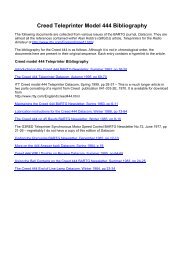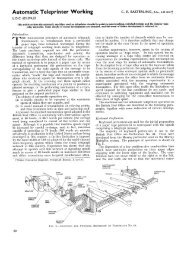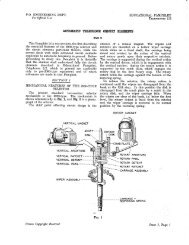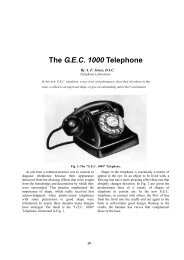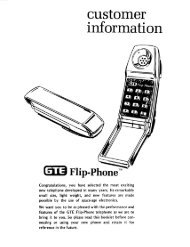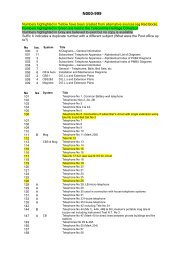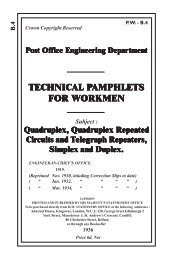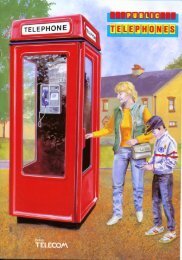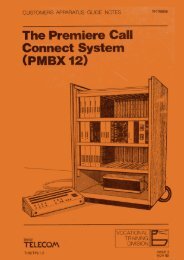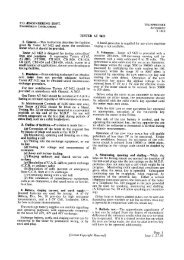TRAFFIC CONTROL TELEPHONE SYSTEMS Circuit - Sam Hallas
TRAFFIC CONTROL TELEPHONE SYSTEMS Circuit - Sam Hallas
TRAFFIC CONTROL TELEPHONE SYSTEMS Circuit - Sam Hallas
Create successful ePaper yourself
Turn your PDF publications into a flip-book with our unique Google optimized e-Paper software.
Page 20<br />
One segment is flat and in close contact with the impulse wheel and keeps K1<br />
and K2 closed, whilst the other has a bent up portion which clears the wheel by<br />
approximately ¼ inch and engages the insulated piece on K2, thus raising the spring<br />
sufficiently to keep the contacts open during this period. The setting of the segments<br />
is done by counting the first number of the code from the first tooth (remembering<br />
that the top of a tooth is one impulse and the space between the teeth is also one<br />
impulse) in a clockwise direction and the last number of the code from the ringing<br />
position in a counter-clockwise direction. As the total number of impulses is 17 for all<br />
codes, it follows that if the first and last digits are correct the space between the two<br />
segments must give a number of impulses equal to the middle number of the code.<br />
During the inter-digital pauses the condition of K1, K2 contacts (open or closed)<br />
must be maintained, therefore, if the digit ends on a tooth use a flat coding segment,<br />
if in a space use a bent-up segment. Thus, two of either style or one of each will be<br />
required for each key as indicated in the following table.<br />
Referring to Fig. 7, the key is shown set for the code 3-11-3 using a flat and a<br />
bent up segment. When the impulse wheel rotates K1 makes contact with K3,<br />
through the impulse wheel, for a comparatively long period before impulsing. This<br />
gives a wide margin for the operation of the battery relay before the impulsing period<br />
commences. The initial operation of K1, K3 connects battery to the line (over the<br />
battery relay contacts) and transmits an impulse. This isolated impulse advances all<br />
selectors one step which clears them from any code pins, on which they may have<br />
held during a previous transmission and prepares them for the code about to be sent.<br />
K1 then moves to the top of the first tooth which closes K1, K2 K1 still in contact<br />
with K3) thus operating the battery reversing relay and transmitting the first impulse<br />
of the code. K1 then drops into the space between the first and second teeth, opening<br />
K1 and K2 contacts, so releasing the reversing relay, thus transmitting the second<br />
impulse. (This procedure is repeated for as many impulses as there are in the digit).<br />
The third and last impulse of the first digit is made by a closure of K1, K2 contacts,<br />
therefore they must remain closed during the inter-digital pause, so a flat segment is<br />
used as shown. Counting counter-clockwise from the ringing position, for the third<br />
digit, we find that it starts on the top of a tooth which indicates that the second digit<br />
ended in a space, we therefore use a bent up segment in the position shown. With the<br />
two segments in position the second digit automatically becomes 11 because 17 is the<br />
total impulses.



